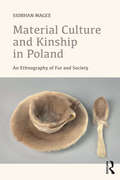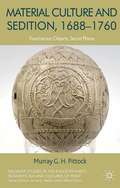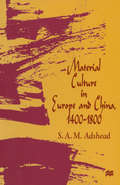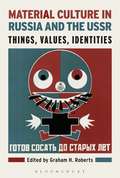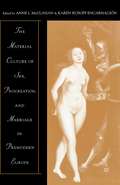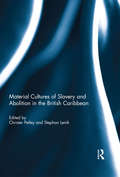- Table View
- List View
Material Culture and Kinship in Poland: An Ethnography of Fur and Society
by Siobhan MageeIn this ethnography of Krakowian society, Siobhan Magee explores essential questions on the relationship between fur and culture in Poland. How can wearing a fur coat indicate someone's political views in Krakow, beyond their opinion on animal rights? What kinds of associations are given to someone wearing a fur coat in Poland? And what impact does generational difference have on the fur-wearing traditions of modern day Krakowians? Magee looks further into detailed analyses of conversations held relating to fur, including why fur is an apt inheritance for a grandmother to pass on to her granddaughter; what it was like trading fur on 'black markets' during socialism, and why some anti-fur activists link fur to patriarchal power and the Roman Catholic Church. In so doing, it becomes clear how fur is an evocative textile with an uncommonly rich symbolic and historical significance."Magee's research uncovers the symbolic and historic significance that fur evokes in relation to culture in Poland. In her investigations, her ethnography becomes a means for understanding generational difference in Poland. Written with reference to extensive fieldwork, Magee goes on to show how the classification of generation can be a much more accessible indicator and measure of difference than other categories, including sexuality, class and faith. Thus, 'generation' and 'inheritance' are shown to be uniquely powerful idioms with which to discuss power and social change in Poland. A new contribution to material culture and the sensory turn, this will be of interest to scholars of anthropology, ethnography, eastern Europe and material culture and textiles.
Material Culture and Sedition, 1688-1760: Treacherous Objects, Secret Places (Palgrave Studies in the Enlightenment, Romanticism and Cultures of Print)
by M. PittockMaterial Culture and Sedition, 1688-1760 is a groundbreaking study of the ways in which material culture (and its associated designs, rituals and symbols) was used to avoid prosecution for treason and sedition in the British Isles. The fresh theoretical model it presents challenges existing accounts of the public sphere and consumer culture.
Material Culture in America: Understanding Everyday Life
by Helen Sheumaker Shirley WajdaThe first encyclopedia to look at the study of material culture (objects, images, spaces technology, production, and consumption), and what it reveals about historical and contemporary life in the United States.Reaching back 400 years, Material Life in America: An Encyclopedia is the first reference showing what the study of material culture reveals about American society—revelations not accessible through traditional sources and methods.In nearly 200 entries, the encyclopedia traces the history of artifacts, concepts and ideas, industries, peoples and cultures, cultural productions, historical forces, periods and styles, religious and secular rituals and traditions, and much more. Everyone from researchers and curators to students and general readers will find example after example of how the objects and environments created or altered by humans reveal as much about American life as diaries, documents, and texts.
Material Culture in Europe and China, 1400–1800: The Rise of Consumerism
by S.A.M. AdsheadThis book reinterprets the rise of consumerism in terms of interaction between Europe and China 1400-1800. In particular, it examines the intellectual foundations of consumerism in food, dress, shelter, utilities, information and symbolism. It highlights consumerism as an expression of both rationality and freedom and indicates the constructive role it has played in the formation of the modern world. Particular use is made of comparisons between developments in Europe and China to differentiate both.
Material Culture in Russia and the USSR: Things, Values, Identities
by Graham H. RobertsMaterial Culture in Russia and the USSR comprises some of the most cutting-edge scholarship across anthropology, history and material and cultural studies relating to Russia and the Soviet Union, from Peter the Great to Putin.Material culture in Russia and the USSR holds a particularly important role, as the distinction between private and public spheres has at times developed in radically different ways than in many places in the more commonly studied West. With case studies covering alcohol, fashion, cinema, advertising and photography among other topics, this wide-ranging collection offers an unparalleled survey of material culture in Russia and the USSR and addresses core questions such as: what makes Russian and Soviet material culture distinctive; who produces it; what values it portrays; and how it relates to 'high culture' and consumer culture.
The Material Culture of Sex, Procreation, and Marriage in Premodern Europe
This interdisciplinary anthology takes as its starting point the belief that, as the material grounds of lived experience, material culture provides an avenue of historical access to women's lives, extending beyond the reaches of textual evidence. Studies here range from utilitarian tools used in Late Roman abortion to sacred, magical or ritual objects associated with sex, procreation, and marriage in the Renaissance. Together the essays demonstrate the complex relationship between language and object, and explore the ways in which objects become forms of communication in their own right, transmitting both rather specific messages and more generalized social and cultural values.
The Material Culture of Steamboat Passengers: Archaeological Evidence from the Missouri River (The Springer Series in Underwater Archaeology)
by Annalies CorbinFor many years, one of my favorite classroom devices in historical archaeology was to ask the students to imagine that they had to make the choice between saving—from some unnamed calamity—all master’s theses or all doctoral disser tations in anthropology, but not both. Like good students, they usually looked to their Ph.D. holding professor and chose the dissertations. Much to their surprise, Iwouldrespondthatthetheseswould win withouteventakingtime to ponderthe issue. The issue is clearly one of often naïve and rarely eloquent theses full of good primary data versus sometimes more sophisticated and better written works full of irrelevant theory and meaningless statistics. Perhaps this is an overstate ment of the situation, but it is not too far offthe mark. The University Microfilms International efforts to make the titles of disser tations in North America and the English speaking portions of Europe available through Dissertation Abstracts is commendable. With only one minor exception, dissertations in historical and underwater archaeology in the United States are to be found listed in Dissertation Abstracts and thus are available for purchase.
The Material Culture of Tableware: Staffordshire Pottery and American Values
by Jeanne Morgan ZarucchiThe Material Culture of Tableware is a fascinating and authoritative study of patterned tableware in the US. The book undertakes a visual analysis of Johnson Brothers patterns of tableware pottery, with reference to comparable designs by other British companies, such as Spode and Adams. It examines how this practical genre reflected the aesthetic values, sense of identity and aspirations of the American consumers who purchased its products. The study also sheds light on British opinions and understandings of American culture. The book's chronological organization shows how tableware designs reflected the cultural developments of American society during the long 20th century. From status-seeking 1890s beaux-arts patterns and the nostalgic historical scenes of the 1930s, to whimsical 1960s patterns and the contemporary motifs of the 1970s, The Material Culture of Tableware tells a compelling story about who 20th century middle-class Americans were and wanted to be.
The Material Culture of Tableware: Staffordshire Pottery and American Values
by Jeanne Morgan ZarucchiThe Material Culture of Tableware is a fascinating and authoritative study of patterned tableware in the US. The book undertakes a visual analysis of Johnson Brothers patterns of tableware pottery, with reference to comparable designs by other British companies, such as Spode and Adams. It examines how this practical genre reflected the aesthetic values, sense of identity and aspirations of the American consumers who purchased its products. The study also sheds light on British opinions and understandings of American culture. The book's chronological organization shows how tableware designs reflected the cultural developments of American society during the long 20th century. From status-seeking 1890s beaux-arts patterns and the nostalgic historical scenes of the 1930s, to whimsical 1960s patterns and the contemporary motifs of the 1970s, The Material Culture of Tableware tells a compelling story about who 20th century middle-class Americans were and wanted to be.
Material Cultures of Childhood in Second World War Britain (Material Culture and Modern Conflict)
by Gabriel MoshenskaHow do children cope when their world is transformed by war? This book draws on memory narratives to construct an historical anthropology of childhood in Second World Britain, focusing on objects and spaces such as gas masks, air raid shelters and bombed-out buildings. In their struggles to cope with the fears and upheavals of wartime, with families divided and familiar landscapes lost or transformed, children reimagined and reshaped these material traces of conflict into toys, treasures and playgrounds. This study of the material worlds of wartime childhood offers a unique viewpoint into an extraordinary period in history with powerful resonances across global conflicts into the present day.
Material Cultures of Childhood in Second World War Britain (Material Culture and Modern Conflict)
by Gabriel MoshenskaHow do children cope when their world is transformed by war? This book draws on memory narratives to construct an historical anthropology of childhood in Second World Britain, focusing on objects and spaces such as gas masks, air raid shelters and bombed-out buildings. In their struggles to cope with the fears and upheavals of wartime, with families divided and familiar landscapes lost or transformed, children reimagined and reshaped these material traces of conflict into toys, treasures and playgrounds. This study of the material worlds of wartime childhood offers a unique viewpoint into an extraordinary period in history with powerful resonances across global conflicts into the present day.
Material Cultures of Early Modern Women's Writing (Early Modern Literature in History)
by Patricia Pender Rosalind SmithThis collection examines the diverse material cultures through which early modern women's writing was produced, transmitted, and received. It focuses on the ways it was originally packaged and promoted, how it circulated in its contemporary contexts, and how it was read and received in its original publication and in later revisions and redactions.
The Material Cultures of Enlightenment Arts and Sciences (Palgrave Studies in the Enlightenment, Romanticism and Cultures of Print)
by Adriana CraciunIn this book the eighteenth century Enlightenment receives an important reassessment, using an astonishing range of materials and objects drawn from Europe and beyond, including artefacts from India and China, West Africa and Polynesia. A series of authoritative essays written by experts in the field explores the full range of material culture in the long eighteenth century, raising crucial questions about notions of property and invention, homely and commercial lives. The book also includes a series of well-illustrated exhibits, a startling and provocative assemblage of objects from the Enlightenment world, each accompanied by expert commentaries. The collection of essays and exhibits is the result of collaborative debate by scholars from Europe and north America, who have together worked on the cross-disciplinary importance of material history in making sense of how past society was fundamentally transformed through the world of goods.
Material Cultures of Music Notation: New Perspectives on Musical Inscription (Music and Material Culture)
by Floris SchuilingMaterial Cultures of Music Notation brings together a collection of essays that explore a fundamental question in the current landscape of musicology: how can writing and reading music be understood as concrete, material practices in a wider cultural context? Drawing on interdisciplinary approaches from musicology, media studies, performance studies, and more, the chapters in this volume offer a wide array of new perspectives that foreground the materiality of music notation. From digital scores to the transmission of manuscripts in the Middle Ages, the volume deliberately disrupts boundaries of discipline, historical period, genre, and tradition, by approaching notation's materiality through four key interrelated themes: knowledge, the body, social relations, and technology. Together, the chapters capture vital new work in an essential emerging area of scholarship.
Material Cultures of Music Notation: New Perspectives on Musical Inscription (Music and Material Culture)
by Floris Schuiling Emily PayneMaterial Cultures of Music Notation brings together a collection of essays that explore a fundamental question in the current landscape of musicology: how can writing and reading music be understood as concrete, material practices in a wider cultural context? Drawing on interdisciplinary approaches from musicology, media studies, performance studies, and more, the chapters in this volume offer a wide array of new perspectives that foreground the materiality of music notation. From digital scores to the transmission of manuscripts in the Middle Ages, the volume deliberately disrupts boundaries of discipline, historical period, genre, and tradition, by approaching notation's materiality through four key interrelated themes: knowledge, the body, social relations, and technology. Together, the chapters capture vital new work in an essential emerging area of scholarship.
Material Cultures of Psychiatry (Histoire #155)
by Monika Ankele Benoît MajerusIn the past, our ideas of psychiatric hospitals and their history have been shaped by objects like straitjackets, cribs, and binding belts. These powerful objects were often used as a synonym for psychiatry and the way psychiatric patients were treated, yet very little is known about the agency of these objects and their appropriation by staff and patients. By focusing on material cultures, this book offers a new perspective on the history of psychiatry: it enables a narrative in which practicing psychiatry is part of a complex entanglement in which power is constantly negotiated. Scholars from different academic disciplines show how this material-based approach opens up new perspectives on the agency and imagination of men and women inside psychiatry.
Material Cultures Of Slavery And Abolition In The British Caribbean
by Christer Petley Stephan LenikMaterial things mattered immensely to those who engaged in daily struggles over the character and future of slavery and to those who subsequently contested the meanings of freedom in the post-emancipation Caribbean. Throughout the history of slavery, objects and places were significant to different groups of people, from the opulent master class to enslaved field hands as well as to other groups, including maroons, free people of colour and missionaries, all of who shared the lived environments of Caribbean plantation colonies. By exploring the rich material world inhabited by these people, this book offers new ways of seeing history from below, of linking localised experiences with global transformations and connecting deeply personal lived realities with larger epochal events that defined the history of slavery and its abolition in the British Caribbean. This book was originally published as a special issue of Slavery & Abolition.
Material Cultures Of Slavery And Abolition In The British Caribbean (PDF)
by Christer Petley Stephan LenikMaterial things mattered immensely to those who engaged in daily struggles over the character and future of slavery and to those who subsequently contested the meanings of freedom in the post-emancipation Caribbean. Throughout the history of slavery, objects and places were significant to different groups of people, from the opulent master class to enslaved field hands as well as to other groups, including maroons, free people of colour and missionaries, all of who shared the lived environments of Caribbean plantation colonies. By exploring the rich material world inhabited by these people, this book offers new ways of seeing history from below, of linking localised experiences with global transformations and connecting deeply personal lived realities with larger epochal events that defined the history of slavery and its abolition in the British Caribbean. This book was originally published as a special issue of Slavery & Abolition.
Material Cultures of Slavery and Abolition in the British Caribbean
by Christer Petley and Stephan LenikMaterial things mattered immensely to those who engaged in daily struggles over the character and future of slavery and to those who subsequently contested the meanings of freedom in the post-emancipation Caribbean. Throughout the history of slavery, objects and places were significant to different groups of people, from the opulent master class to enslaved field hands as well as to other groups, including maroons, free people of colour and missionaries, all of who shared the lived environments of Caribbean plantation colonies. By exploring the rich material world inhabited by these people, this book offers new ways of seeing history from below, of linking localised experiences with global transformations and connecting deeply personal lived realities with larger epochal events that defined the history of slavery and its abolition in the British Caribbean.This book was originally published as a special issue of Slavery & Abolition.
Material Cultures of Slavery and Abolition in the British Caribbean
by Christer Petley Stephan LenikMaterial things mattered immensely to those who engaged in daily struggles over the character and future of slavery and to those who subsequently contested the meanings of freedom in the post-emancipation Caribbean. Throughout the history of slavery, objects and places were significant to different groups of people, from the opulent master class to enslaved field hands as well as to other groups, including maroons, free people of colour and missionaries, all of who shared the lived environments of Caribbean plantation colonies. By exploring the rich material world inhabited by these people, this book offers new ways of seeing history from below, of linking localised experiences with global transformations and connecting deeply personal lived realities with larger epochal events that defined the history of slavery and its abolition in the British Caribbean.This book was originally published as a special issue of Slavery & Abolition.
Material Cultures of the Global Eighteenth Century: Art, Mobility, and Change (Material Culture of Art and Design)
by Wendy Bellion and Kristel SmentekThings change. Broken and restored, reused and remade, objects transcend their earliest functions, locations, and appearances. While every era witnesses change, the eighteenth century experienced artistic, economic, and demographic transformations that exerted unique pressures on material cultures around the world. Locating material objects at the heart of such phenomena, Material Cultures of the Global Eighteenth Century expands beyond Eurocentric perspectives to discover the mobile, transcultural nature of eighteenth-century art worlds. From porcelain to betel leaves, Chumash hats to natural history cabinets, this book examines how objects embody imperialism, knowledge, and resistance in various ways. By embracing things both elite and everyday, this volume investigates physical and technological manipulations of objects while attending to the human agents who shaped them in an era of accelerating global contact and conquest. Featuring ten essays, the volume foregrounds diverse scholarly approaches to chart new directions for art history and cultural history. Ranging from California to China, Bengal to Britain, Material Cultures of the Global Eighteenth Century illuminates the transformations within and between artistic media, follows natural and human-made things as they migrate across territories, and reveals how objects catalyzed change in the transoceanic worlds of the early modern period.
Material Cultures of the Global Eighteenth Century: Art, Mobility, and Change (Material Culture of Art and Design)
Things change. Broken and restored, reused and remade, objects transcend their earliest functions, locations, and appearances. While every era witnesses change, the eighteenth century experienced artistic, economic, and demographic transformations that exerted unique pressures on material cultures around the world. Locating material objects at the heart of such phenomena, Material Cultures of the Global Eighteenth Century expands beyond Eurocentric perspectives to discover the mobile, transcultural nature of eighteenth-century art worlds. From porcelain to betel leaves, Chumash hats to natural history cabinets, this book examines how objects embody imperialism, knowledge, and resistance in various ways. By embracing things both elite and everyday, this volume investigates physical and technological manipulations of objects while attending to the human agents who shaped them in an era of accelerating global contact and conquest. Featuring ten essays, the volume foregrounds diverse scholarly approaches to chart new directions for art history and cultural history. Ranging from California to China, Bengal to Britain, Material Cultures of the Global Eighteenth Century illuminates the transformations within and between artistic media, follows natural and human-made things as they migrate across territories, and reveals how objects catalyzed change in the transoceanic worlds of the early modern period.
Material Dreams: Southern California through the 1920s (Americans and the California Dream)
by Kevin StarrKevin Starr is the foremost chronicler of the California dream and indeed one of the finest narrative historians writing today on any subject. The first two installments of his monumental cultural history, "Americans and the California Dream," have been hailed as "mature, well-proportioned and marvelously diverse (and diverting)" (The New York Times Book Review) and "rich in details and alive with interesting, and sometimes incredible people" (Los Angeles Times). Now, in Material Dreams, Starr turns to one of the most vibrant decades in the Golden State's history, the 1920s, when some two million Americans migrated to California, the vast majority settling in or around Los Angeles. In a lively and eminently readable narrative, Starr reveals how Los Angeles arose almost defiantly on a site lacking many of the advantages required for urban development, creating itself out of sheer will, the Great Gatsby of American cities. He describes how William Ellsworth Smyth, the Peter the Hermit of the Irrigation Crusade, the self-educated, Irish engineer William Mulholland (who built the main aquaducts to Los Angeles), and George Chaffey (who diverted the Colorado River, transforming desert into the lush Imperial Valley) brought life-supporting water to the arid South. He examines the discovery of oil, the boosters and land developers, the evangelists (such as Bob Shuler, the Methodist Savanarola of Los Angeles, and Aimee Semple McPherson), and countless other colorful figures of the period. There are also fascinating sections on the city's architecture the impact of the automobile on city planning, the Hollywood film community, the L.A. literati, and much more. By the end of the decade, Los Angeles had tripled in population and become the fifth largest city in the nation. In Material Dreams, Starr captures this explosive growth in a narrative tour de force that combines wide-ranging scholarship with captivating prose.
The Material Dynamics of Festivals in the Graeco-Roman East (Oxford Studies in Ancient Documents)
by Zahra NewbyThe Material Dynamics of Festivals in the Graeco-Roman East explores the various ways in which the experience of civic festivals in the Graeco-Roman East was created and framed by material culture. By the second and third centuries AD, Greek festivals were thriving across the eastern Mediterranean. Much of our knowledge of these festivals, and their associated processions, rituals, banquets, and competitions, comes from material culture— inscriptions, coins, architecture, and art-works. Yet each of these pieces of material evidence was the result of a conscious act, of what to record, and where and how to record it, with varying patterns discernible across different areas, and in different media. This volume draws attention to the choices made in a variety of different forms of material culture relating to Greek festivals from the Hellenistic to Roman periods, and unpicks the ways in which they encode or forge particular social relationships and power structures, as well as creating senses of community or communication between different groups. These helped to fix ephemeral events into public memory, to present particular views of their significance for the wider community, and to frame the experience of their participants.
The Material Dynamics of Festivals in the Graeco-Roman East (Oxford Studies in Ancient Documents)
The Material Dynamics of Festivals in the Graeco-Roman East explores the various ways in which the experience of civic festivals in the Graeco-Roman East was created and framed by material culture. By the second and third centuries AD, Greek festivals were thriving across the eastern Mediterranean. Much of our knowledge of these festivals, and their associated processions, rituals, banquets, and competitions, comes from material culture— inscriptions, coins, architecture, and art-works. Yet each of these pieces of material evidence was the result of a conscious act, of what to record, and where and how to record it, with varying patterns discernible across different areas, and in different media. This volume draws attention to the choices made in a variety of different forms of material culture relating to Greek festivals from the Hellenistic to Roman periods, and unpicks the ways in which they encode or forge particular social relationships and power structures, as well as creating senses of community or communication between different groups. These helped to fix ephemeral events into public memory, to present particular views of their significance for the wider community, and to frame the experience of their participants.
